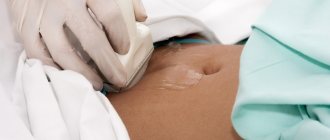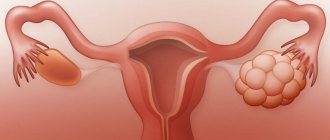Ovarian dysfunction - what is it? Symptoms and treatment Ovarian dysfunction - a pathological condition is not a disease, but is a consequence of an imbalance in the female reproductive system of the body. Irregularities in the menstrual cycle due to any, even minor, disease cause ovarian dysfunction.
Many women get used to these features of the disease and do not pay appropriate attention to the situation that has arisen. However, disruption of the hormonal functioning of the ovaries can lead to sad results: causing infertility, recurrent miscarriage, persistent changes in the menstrual cycle, and even cancer.
Causes
According to the ICD 10 protocol, pathology is divided into provoked:
- excess estrogens or androgens;
- unspecified reasons;
- Stein-Leventhal syndrome (PCOS or polycystic ovarian tissue);
- primary ovarian failure (absence or inertia of follicles);
- other types of pathogens.
In other words, there is a failure at the level of hormone production, and as a result, the functioning of the ovaries is disrupted: i.e. dysfunction appears. But, in fact, why does the process start?
This may be due to:
- Obesity.
- Congenital anomalies of the ovary (torsion, etc.).
- Formation of tumors or cysts in the reproductive organs.
- Inflammatory phenomena at any level of the genitourinary system (uterus, ovaries), for example: cervicitis, oophoritis, STD, etc.
- Acute and chronic stress, constant fatigue.
- Miscarriages and abortions. The termination of the first pregnancy is especially dangerous, since it is a significant blow to the hormonal balance of the body.
- Endocrine ailments of various origins that undermine the body’s hormonal balance (for example, problems in the functioning of the pancreas and thyroid gland).
- Incorrectly installed intrauterine device (IUD), incorrect selection and use of hormonal contraceptives.
- To a lesser extent, the disease can be triggered by a sharp change in climate, high levels of insolation, and environmental pollution.
Under the influence of provocateurs, processes occur in the body that interfere with the proper synthesis of female hormones (such as prolactin, luteinizing and follicle-stimulating hormone). This is what disrupts the normal rhythm of the reproductive organs, provoking various complications and pathologies.
Why does hormonal imbalance occur?
Oddly enough, most often, quite banal, at first glance, phenomena lead to disturbances in the process of hormone production:
- general overload - physical and moral, constant stress;
- frequent illnesses and weakened immunity;
- age-related changes : hormonal surge in adolescence; pregnancy, childbirth and lactation; menopause;
- any infections , including sexually transmitted ones;
- abortions and existing surgical interventions in the reproductive system , for example, uterine curettage;
- uncontrolled use of hormonal drugs .
Hormonal imbalances very often cause serious gynecological diseases, so it is important to monitor them in a timely manner. Moreover, in the initial stages it is quite easy to restore balance; there are a lot of inexpensive pharmaceuticals for this.
Symptoms of ovarian dysfunction
During each phase of the monthly cycle, the pituitary gland produces the hormones FLH, LH and PRL in such a special ratio that ensures the synthesis of the egg, its maturation and release from the ovary, as well as the cyclicity of monthly discharge.
Any normal cycle consists of 4-7 days of menstrual flow and 21-30 days between their onset. The volume of normal discharge during one menstruation is up to 100 ml. Any deviations from these norms are considered violations. Malfunction of the pituitary gland and insufficient production of certain hormones that ensure the functioning of the ovaries leads to the following changes in the body:
- Menstrual cycle disorders. Menstruation can be very scanty or, on the contrary, extremely intense, too profuse, occur once every one and a half to two weeks, or be absent for a long period of time.
- If there is no menstruation for more than six months, it is called amenorrhea.
- Premenstrual syndrome becomes more pronounced, tearfulness alternates with increased aggression and complete apathy to what is happening, weakness.
- Painful sensations. The lower abdomen often hurts, the pain is aching, as if pulling, and at times unbearable.
- Disruption of the process of ovulation and egg maturation. This is the most direct path to infertility; it becomes impossible to fulfill the cherished desire to become a mother and safely bear a child.
In addition to these symptoms, there may be additional signs of a disease that causes hormonal disorders.
What is the disease
Ovulation, during which an egg is released from the ovary, is a necessary condition for pregnancy. Doctors distinguish two main types of disruption of this process:
- Oligoovulation, in which ovulation occurs irregularly, but is not completely absent.
- Anovulation, in which the process of ovulation does not occur at all.
Anovulation and oligoovulation are key manifestations of ovarian dysfunction in women. The disease very often leads to female infertility. When a woman has anovulation, she is unable to become pregnant due to the complete absence of mature eggs. If a woman has inconsistent ovulation, then the likelihood of conception decreases. In addition, late ovulation leads to the production of less viable eggs, which indirectly makes fertilization less likely.
If ovulation does not occur, then the woman does not have menstruation. There is no observed menstrual bleeding. During a normal menstrual cycle, a number of hormonal substances have a targeted effect on the uterus and thicken the endometrium. If conception does not occur, the level of hormones drops, and the thickened layer of the endometrium is destroyed with the release of blood. It is for this reason that women with ovarian dysfunction do not have regular menstruation. Cycle variability can vary greatly. In addition, women with ovarian disease may experience persistent vaginal bleeding for a week or even longer.
Dysfunction at different ages
The described condition is characterized by a change in the ratio of hormones necessary for the ovulation process. As a rule, ovulation does not occur (anovulation state).
- Ovarian dysfunction in adolescents is associated with disorders in the brain, or rather, in the hypothalamus-pituitary system. The causes of such disorders can be brain injuries, infectious diseases (meningitis), as well as viral and infectious diseases (ARVI, influenza, rubella, measles, tonsillitis and others). As a rule, the viruses that cause these diseases are localized in the pituitary gland and hypothalamus, thereby provoking the acyclicity of juvenile menstruation.
- Ovarian dysfunction during the reproductive period is most often accompanied by an increased level of estrogen, which increases the risk of uterine tumors (fibroids), endometriosis, malignant neoplasms of the mammary glands, and mastopathy.
- Ovarian dysfunction in the premenopausal period is characterized by uterine bleeding. The basis of menopausal bleeding is disturbances in the maturation of follicles, resulting in endometrial hyperplasia. In addition, climacteric ovarian dysfunction is observed with the development of hormonally active tumors in the ovaries, which are often diagnosed during these years.
Wellness procedures, routine vaccinations, timely treatment of colds, and nutritious nutrition will make it possible not to experience first-hand what ovarian dysfunction is.
The consequences of ovarian dysfunction bring many complications and troubles for women. These are problems with pregnancy and bearing a child. In addition, ovarian dysfunction causes diseases such as mastopathy, cystic ovarian pathology, cancer of the uterus and ovaries.
Pathology of ovarian hormones
A number of endocrine disorders
can lead to ovarian dysfunction through disruption of the hypothalamic-pituitary-ovarian system.
For example, with hyperprolactinemia, the secretion of luliberin is suppressed. Similarly, increased TRH activity in women with hypothyroidism ultimately leads to decreased pulsatile LH release due to the direct stimulatory effect of TRH on prolactin secretion. Hyperthyroidism
can lead to a variety of menstrual irregularities, from frequent heavy bleeding to amenorrhea.
Congenital adrenal hyperplasia
as a cause of anovulation and ovarian dysfunction. In women with both classic and late-onset CAH, ovarian dysfunctions similar to those that occur with PCOS are possible. Menstrual irregularities in these women were initially explained by suppression of glucocorticoid synthesis in the adrenal glands, leading to suppression of the hypothalamic-pituitary-ovarian axis.
Noted, especially in classic congenital adrenal hyperplasia
(OHN), features of ovarian hyperandrogenism similar to PCOS, even with adequate adrenal suppression using dexamethasone.
It is believed that perinatal exposure to increased androgens
in women with congenital adrenal hyperplasia (CAH) leads to hypersecretion of LH in response to stimulation with luliberin during puberty. This leads to the development of ovarian hyperandrogenism, regardless of the suppression of excessive androgen synthesis in the adrenal glands. Similar disorders have been reported in late-onset CAH.
Luteal phase defects
as a cause of anovulation and ovarian dysfunction. Luteal phase defect is a unifying concept that causes debate about the legitimacy of its existence. The bottom line is the abnormal development of the endometrium in the luteal phase, which leads to a weakening of the endometrium’s ability to implant an embryo and early miscarriages. Qualitative or quantitative progesterone deficiency is the main factor in the pathological development of the endometrium. There are probably two types of violations.
• Short luteal phase (less than 10 days). It is usually identified by determining the amount of LH in the urine or plotting a BBT. This is a secondary suppression of pulsatile secretion of luliberin, leading to inadequate luteinization and decreased progesterone production. A short luteal phase occurs together with other endocrine disorders (for example, hyperprolactinemia or hypothyroidism), as well as during hypothalamic-pituitary suppression accompanying lactational amenorrhea, when using steroid contraceptives and intense physical activity. Elimination of the root cause usually leads to normalization of the luteal phase.
• Violation of endometrial development. Histological studies of the endometrium show that its development is delayed by 2 days or more compared to normal chronology. This condition is often independent of the length of the luteal phase. This variant of the luteal phase defect, as it turns out, occurs due to insufficient secretion of progesterone or an inadequate response of the endometrium to progesterone.
Although etiology
has not been fully studied, this defect usually occurs against the background of increased concentrations of hormones, which accompanies stimulation of the ovaries by exogenous gonadotropins during therapy with luliberin analogues (or without it).
However, the role of luteal phase defect
in infertility remains controversial. Studies of this problem have demonstrated a significant prevalence of luteal phase defects in women of fertile age, and there is disagreement regarding diagnostic criteria. Histological studies of endometrium taken from repeated biopsies are often uninformative, and the results are too variable among different pathologists. Similarly, there is no agreement on the issue of normal serum progesterone levels.
Finally, the lack of clarity in studies of the effect of progesterone
raised doubts about the importance of luteal phase defect as a cause of infertility.
Luteinized unruptured follicle
as a cause of anovulation and ovarian dysfunction. There are reports that luteinized unruptured follicle syndrome can be a transient or permanent cause of ovarian disorders. The syndrome is characterized by the absence of signs of ovulation by ultrasound or laparoscopy (48-72 hours after the LH peak).
This phenomenon
may occur in parallel (in time) with periovulatory use of NSAIDs, leading to the abolition of prostaglandin-induced follicular rupture. In other cases, this occurs when inadequate doses of human chorionic gonadotropin are injected to induce ovulation. Apart from iatrogenic cases, the etiology is not precisely known, there is no generally accepted treatment algorithm, diagnostic criteria are controversial, they vary widely and in some cases are based on different approaches. In our country, only 8% of doctors working in university centers with certificates in reproductive endocrinology conduct examinations to verify this diagnosis.
Ovarian dysfunction during pregnancy
Pregnancy and dysfunctional ovarian disorder are incompatible things. But if conception does occur, the following scenarios are possible:
- There is no dysfunction, since pregnancy should exclude it. In this case, the ovary is at rest, only the corpus luteum is working.
- Dysfunction disrupts the hCG-progesterone connection, against the background of which the corpus luteum begins to fade, and detachment of the membranes or placenta occurs. This condition threatens spontaneous termination of pregnancy or fading of fetal development.
- Dysfunction leads to manifestations of critical periods of pregnancy. A woman may complain of temporary abdominal pain and mucous discharge from the vagina due to increased uterine tone.
A woman’s reproductive system is in a fragile balance and reacts to any disturbances in the general condition of the body. Ovarian dysfunction requires mandatory treatment and the sooner it is carried out, the better. This disease is scary not for its clinical manifestations, but for its dangerous long-term consequences in the form of infertility, endocrine disorders, mastopathy and tumors of various origins.
Clinical picture of the disease
Ovarian dysfunction is a generalized definition of pathological changes in the female reproductive system, the main symptom of which is hormonal imbalance in the body. Ovarian dysfunction has rather nonspecific symptoms and that is why most women believe that the absence of menstruation for one to two months can be attributed to hypothermia, stress, etc.
But, in this case, you just need to be wary, because ovarian depletion manifests itself in exactly this way. If a woman has not had a menstrual period for more than 35 days, then bleeding occurs, which lasts about a week, then this is dysfunctional uterine bleeding.
The cause of dysfunctional uterine bleeding is that the hormones of the female reproductive system are secreted in insufficient quantities. Ovarian dysfunction, first of all, has a hormonal nature of prolactin, follicle-stimulating and luteinizing hormones. As is known, the phases of the menstrual cycle are strictly subject to the influence of these hormones.
If the ratio of hormones is disturbed, then dysfunction of the organs of the reproductive system occurs. At the initial stage, it manifests itself in the form of a lack of ovulation. This is the reason that a woman’s cycle does not affect all the necessary phases, so it begins to go astray.
External manifestations of pathology
Symptoms of ovarian dysfunction are expressed primarily in anovulation of the menstrual cycle. Hormones will be in a disproportionate ratio: progesterone will be in short supply, and estrogen will be in excess. Ovarian dysfunction is expressed in the following symptoms:
- Lack of menstruation for several months;
- Irregular menstruation;
- Heavy bleeding between periods;
- Infertility;
- Spontaneous abortions (miscarriages);
- Dull or cramping pain before the onset of menstruation or ovulation;
- Weakness in the body, lethargy, increased emotionality before the onset of menstruation;
- Pronounced premenstrual syndrome;
- Menstrual bleeding that occurs outside the cycle, namely rare (no more than once every 70 days), frequent (every 20-21 days), heavy (volume of lost blood more than 100-150 ml), as well as menstruation that lasts more than one week;
- Amenorrhea is menstruation that occurs once a year.
Ovarian dysfunction can cause infertility and miscarriage. In addition, ovarian depletion most often appears against the background of the formation of a malignant tumor, ectopic pregnancy, endometriosis, mastopathy, and uterine fibroids.
Diagnostics
To diagnose this pathology, many tests and methods are used. First of all, the doctor collects the patient’s complaints and medical history, conducts an initial gynecological examination, during which obvious and gross pathology (cysts, tumors) can already be suspected. Next, the doctor prescribes a number of general clinical studies:
- collecting blood and urine for general tests;
- blood test for biochemical composition (primarily, determination of glucose levels);
- electrocardiography (to exclude cardiovascular pathology);
- Ultrasound of the pelvic organs (detection of the size of the ovaries, their structure and follicular apparatus, determination of ovulation dynamics);
- taking a smear for vaginal microflora;
- detection of sexually transmitted infections using PCR;
- measuring basal temperature (helps determine which phase of the cycle there are irregularities);
- study of hormonal status (determining the levels of prolactin, FSH, LH, progesterone and estrogens).
If necessary, tests of the level of hormones produced by the thyroid gland and adrenal glands (urine and blood), as well as radiography of the skull (detection of the “empty sella” syndrome, pituitary tumors and other pathologies), CT and MRI of the brain may be prescribed. To check for local changes in the medulla, an EEG of the brain is prescribed.
Based on the test results, hysteroscopy is performed, during which the uterine cavity is scraped out and a mandatory histological examination of the scraping is carried out. If there are difficulties in confirming the diagnosis, diagnostic laparoscopy should be performed. [adsen]
Treatment of ovarian dysfunction
If ovarian dysfunction is detected, a gynecologist-endocrinologist is involved in treatment. As a rule, patients with this diagnosis are admitted to the hospital for emergency reasons, that is, with severe bleeding, and treatment begins with relief of the condition. The hemostasis performed can be of 2 types - surgical and symptomatic, which may also include hormonal drugs.
Surgical hemostasis or curettage of the uterine cavity is performed only in case of bleeding that threatens the woman’s life (very low hemoglobin, unconsciousness or profuse bleeding).
- Separate curettage of the cervix and uterine cavity is performed with further histological examination of the scraping.
- Then, until the bleeding stops completely, symptomatic therapy is prescribed, sometimes with elements of hormones (ascorbic acid, uterotonics, dicinone, physiotherapy along with combined oral contraceptives).
- The next stage of therapy is the prevention of bleeding. At this stage of treatment, it is recommended to take progesterone medications from days 16 to 25 of the cycle (Norkolut or Duphaston or Utrozhestan).
- At the same time, measures are being taken to treat anemia (the use of iron-containing drugs Ferritab and Sorbifer Durules is prescribed based on the indications for blood transfusion of red blood cells).
- In the final phase of taking protegen-containing drugs for a week, slight or moderate menstrual-like bleeding is observed, the first day of which is the beginning of the menstrual cycle, and in accordance with this, combined oral contraceptives are prescribed. This stage of treatment lasts from 3 to 6 months or more, depending on the woman’s desire to preserve reproductive function.
After stopping the bleeding, the woman is given parallel treatment aimed at eliminating the cause of ovarian dysfunction.
- If she has genital infections and inflammatory diseases, antibacterial and anti-inflammatory therapy is carried out. Usually, after a course of antibiotics, the menstrual cycle and ovulation are restored on their own, without the prescription of hormones.
- If extragenital pathology is diagnosed, the identified diseases are corrected (selection of a treatment regimen for diabetes mellitus, thyroid diseases, etc.)
- If the development of ovarian dysfunction is caused by external factors, it is recommended to correct nutrition, maintain mental and emotional rest, take vitamins, dietary supplements according to the phases of the cycle, and dosed physical activity.
- Ovarian dysfunction, caused by ovarian tumors and cysts, uterine fibroids and endometriosis and other gynecological diseases, is treated depending on the situation (removal of tumors/cysts, administration of hormonal therapy).
It is important to remember that women who have undergone treatment for this pathology are prohibited from having an intrauterine device installed.
Causes of ovarian dysfunction
Ovarian dysfunction is primarily a consequence of the fact that the hormones prolactin and estrogen are not normal. The first thing a woman needs to do is get tested to determine her hormonal levels, and after that we can talk about the causes of the pathology that has arisen.
As a rule, ovarian dysfunction is caused by processes such as:
- Inflammation of the ovaries, appendages or uterus. Similar inflammatory processes occur in a woman’s body when the hygiene of the genital organs is impaired, as well as infection of the vagina through sexual contact with a partner. The infection can also enter the uterus through the blood through the intestines;
- Tumor of the ovaries and uterus - endometriosis, fibroma, malignant tumors;
- Disturbances of the endocrine system;
- Excessive body weight;
- Diabetes;
- Nervous exhaustion, constant stress, depression;
- Abortion during the first pregnancy;
- Violation of the location of the intrauterine device;
- Drug therapy;
- A fundamental change in environmental conditions is a change in climate.
Folk remedies for ovarian dysfunction
Borovaya uterus is definitely one of the favorite remedies of many women who have been cured of problems with the ovaries, uterus and infertility. It’s not for nothing that it’s called a woman’s herb. It is difficult to explain what causes such a wonderful effect of the plant. For treatment, all components of only the aboveground part of this plant should be used.
Recipes for using it:
- Preparation of tincture. For a month, 50 grams are infused in half a liter of vodka. dry chopped herbs. After this time, the tincture is well filtered, and the sediment is thoroughly squeezed out. Take 30-40 drops, diluting with a small amount of water;
- Preparing the infusion. It is used for douching, combined with the internal use of alcohol tincture. It is prepared by infusing a tablespoon of crushed dry grass of the boron uterus in a glass of boiling water for half an hour. It is better if this process takes place over low heat or a water bath. The infusion should stand for 2 hours.
The following folk recipes are also used:
- Wintergreen tincture: infuse 50 grams of vodka in a half-liter jar for two weeks. wintergreen leaves. Take 30-40 drops of tincture three times a day;
- Infusion of coltsfoot and sweet clover herbs. Grind these components separately and then mix them 10:1. Infuse a tablespoon of the mixture in a glass of boiling water. Take 100-150 ml three times a day;
- Infusion of the herb cinquefoil. Prepared by infusing 2 tbsp. in 0.5 liters of boiling water. Take a glass three times a day.
What does the disease lead to?
The main problem that arises when normal ovarian functions fade is the inability to get pregnant. In this condition, the female body is not able to produce eggs, which makes fertilization impossible. If the problem is not detected in time, the disease enters the chronic stage, so it needs to be treated in time.
Prolonged ignoring of alarming symptoms can lead to negative consequences: the development of mastopathy, endometriosis, uterine fibroids, and possible ectopic pregnancy. If measures are not taken in time, infertility develops and the risk of developing cancer increases. Women over 40 years of age should be especially careful when signs of ovarian function decline appear.
Ovarian dysfunction - syndromes
Ovarian dysfunction can be expressed in the form of such pathological conditions as ovarian wasting syndrome, premature ovarian failure syndrome and PCOS - polycystic ovary syndrome.
Ovarian wasting syndrome is a pathological condition of the reproductive system of women aged 14 to 40 years, characterized by the cessation of menstruation. Ovarian dysfunction in this case leads to a sharp decrease in estrogen hormones.
Their deficiency is reflected in the form of external manifestations - increased sweating, decreased sexual function, excessive emotionality. Ovarian wasting syndrome is characterized by a complete cessation of ovulation as such. In fact, a woman enters a premature menopausal phase, the body enters a state of “hibernation”.
Ovarian dysfunction during exhaustion manifests itself in the form of amenorrhea, redness of the skin on the body, difficulty breathing, a state of panic and increased anxiety. A woman experiences pain during sexual intercourse, and her performance and memory are significantly reduced.
Factors influencing decline in organ function
Ovarian wasting syndrome may be hereditary; and also arise as a result of radioactive damage to a woman’s body; after infectious diseases - influenza, rubella; under the influence of toxic chemicals. Ovarian dysfunction may occur after long-term drug treatment; lack of body weight; ectopic pregnancy; after the IVF artificial insemination procedure.
Ovarian depletion syndrome can be treated with vitamin therapy and restoration of the reproductive system through hormonal therapy. Also, hormones such as estrogen and gestagen in high dosages can significantly increase the likelihood of improving a woman’s physiological condition. If polycystic ovary syndromes and their depletion are not treated in time, this can lead to infertility, cardiovascular diseases, and osteoporosis.
Prevention
Many of the recommendations that experts practice are simple and following them will not require much effort and is accessible to everyone. Some of them, the observance of which is a priority:
- It is necessary to establish a nutritious diet with a sufficient amount of vitamins and nutrients and minerals necessary for the body. The correct daily routine with proper rest and a well-established diet, when interacting with the necessary therapeutic methods, helps to more quickly bring the work of all functions of a woman’s body to the appropriate standards.
- Limit physical activity and avoid physical exercise and sports that require physical stress. It has been proven that strenuous physical activity has a negative effect on hormone production, increasing testosterone production.
- Maintaining psycho-emotional stability during periods of exacerbation of stressful situations, not succumbing to despondency and states close to depression. Try to look at current situations from a positive point of view.
- Strict control of body weight and getting rid of excess fat tissue. Fat cells have the ability to synthesize female sex hormones - estrogens, the excess of which causes hormonal dysfunction.
To treat ovarian dysfunction or refuse treatment in cases where the state of health is not very susceptible to changes - such a question should not arise for a modern woman who cares about her health. Elimination of ovarian dysfunction must begin as early as possible, because the consequences of this condition can be very serious and manifest in the form of infertility, uterine fibroids, mastopathy, endocrine disorders with severe manifestations and the occurrence of malignant tumors in the internal genital organs and mammary glands.









